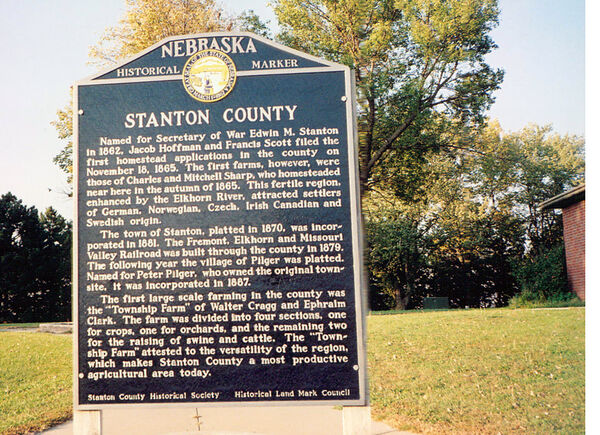Difference between revisions of "Nebraska Historical Marker: Stanton County"
| (2 intermediate revisions by 2 users not shown) | |||
| Line 2: | Line 2: | ||
==Location== | ==Location== | ||
| − | Rural U.S. | + | Rural U.S. 275, Pilger, Stanton County, Nebraska |
View this marker's location '''[https://www.google.com/maps/place/42%C2%B001'09.8%22N+97%C2%B007'38.2%22W/@42.019389,-97.1278222,210m/data=!3m2!1e3!4b1!4m5!3m4!1s0x0:0x0!8m2!3d42.019389!4d-97.127275?hl=en 42.019389, -97.127275]''' | View this marker's location '''[https://www.google.com/maps/place/42%C2%B001'09.8%22N+97%C2%B007'38.2%22W/@42.019389,-97.1278222,210m/data=!3m2!1e3!4b1!4m5!3m4!1s0x0:0x0!8m2!3d42.019389!4d-97.127275?hl=en 42.019389, -97.127275]''' | ||
| − | + | {{Marker:Map}} | |
==Marker Text== | ==Marker Text== | ||
| Line 18: | Line 18: | ||
==Bibliography== | ==Bibliography== | ||
| − | + | Elton A. Perkey, “Perkey’s Nebraska Place Names” (1995), Nebraska State Historical Society | |
| − | + | {{Marker:Program}} | |
| − | + | ||
Latest revision as of 12:45, 25 September 2017
Location
Rural U.S. 275, Pilger, Stanton County, Nebraska
View this marker's location 42.019389, -97.127275
View a map of all Nebraska historical markers, Browse Historical Marker Map
Marker Text
Named for Secretary of War Edwin M. Stanton in 1862, Jacob Hoffman and Francis Scott filed the first homestead applications in the county on November 18, 1865. The first farms, however, were those of Charles and Mitchell Sharp, who homesteaded near here in the autumn of 1865. This fertile region, enhanced by the Elkhorn River, attracted settlers of German, Norwegian, Czech, Irish Canadian and Swedish origin.
The town of Stanton, platted in 1870, was incorporated in 1881. The Fremont, Elkhorn and Missouri Valley Railroad was built through the county in 1879. The following year the village of Pilger was platted. Named for the Peter Pilger, who owned the original townsite, it was incorporated in 1887.
The first large scale farming in the county was the "Township Farm" of Walter Cragg and Ephraim Clark. The farm was divided into four sections, one for crops, one for orchards, and the remaining two sued for the raising of swine and cattle. The "Township Farm" attested to the versatility of the region, which makes Stanton County a most productive agricultural area today.
Further Information
Bibliography
Elton A. Perkey, “Perkey’s Nebraska Place Names” (1995), Nebraska State Historical Society
Marker program
See Nebraska Historical Marker Program for more information.
